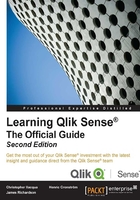
What this book covers
Chapter 1, Qlik Sense® and Data Discovery, covers why Qlik chose to develop Qlik Sense, what data discovery is and can do, and the strategy and vision behind the product. This will include:
- Qlik's history in business intelligence and the evolution of data discovery
- The Qlik philosophy and approach to data discovery
- The difference between traditional BI and data discovery
Chapter 2, Overview of a Qlik Sense® Application's Life Cycle, covers the Qlik Sense application's life cycle overview as a backdrop to highlighting key features and benefits of Qlik Sense in meeting these requirements. There are thousands of features in this initial release and this chapter will serve as a guide to the major components, features, and benefits to start your exploration of Qlik Sense. This will include:
- Overview of the hub
- Starting application authoring
- Components of a Qlik Sense application
- Sharing an application
Chapter 3, Empowering Next Generation Data Discovery Consumers, highlights the key features in the context of specific user requirements that Qlik has identified as a consumer. This will include:
- Data discovery consumption requirements
- The hub
- Navigating and leveraging the associative experience
Chapter 4, Contributing to Data Discovery, highlights the key features in the context of specific user requirements that Qlik has identified as a contributor or someone who seeks to share key findings from their analysis. This will include:
- Data discovery contributor requirements
- Bookmarks
- Private sheets
- Private stories
- Publishing to an existing application
Chapter 5, Authoring Engaging Applications, highlights an approach to building engaging applications to meet your business problems. This will include:
- Data
- KPIs and measures
- Dimensions
- Security
Chapter 6, Building Qlik Sense® Data Models, highlights the techniques and principles behind building a data model. This will include:
- Tables, fields, and records
- Joins and concatenations
- How to link tables and how not to link tables
- Normalization and de-normalization
- Synthetic keys and circular references
Chapter 7, Qlik Sense® Apps in the Cloud, briefs us on using Qlik Sense Cloud. This will include:
- Sharing Qlik Sense Desktop apps in the cloud
- Creating Qlik Sense apps directly in the cloud
- Maintaining Qlik Sense Cloud apps
- Adding external data to apps using Qlik DataMarket
Chapter 8, Extending the Qlik® Analytic Platform, gives an overview of the key APIs and how to use them to extend Qlik Sense solutions. This will include:
- API overview
- Dev Hub
- Single configurator
- Web mashup editor
- Extension editor
- Engine API explorer
- Qlik Branch overview
Chapter 9, Administering Qlik Sense®, highlights the administration of Qlik Sense applications within an organization. This will include:
- Architecture
- Clustering and nodes
- Licenses and tokens
- Streams and security concepts
Chapter 10, Sales Discovery, applies Qlik Sense to the challenges of analyzing sales performance within your organization. This will include:
- Common sales analysis problems
- The unique way Qlik Sense addresses these problems
- How the application was built
Chapter 11, Human Resource Discovery, applies Qlik Sense to the challenges of analyzing human resource data. This will include:
- General information about common KPIs
- What a typical data model could look like
- An example of how to use the global selector
- Examples of dimensions and measures
Chapter 12, Travel Expense Discovery, applies Qlik Sense to the challenges of analyzing travel expense management within an organization. This will include:
- Common travel expense management problems
- The unique way Qlik Sense addresses these problems
- How the application was built
Chapter 13, Demographic Data Discovery, applies Qlik Sense to the challenges of analyzing demographic data. This will include:
- General information about common KPIs
- Examples of how to use the lasso selection with maps and scatter charts
- Examples of dimensions and measures